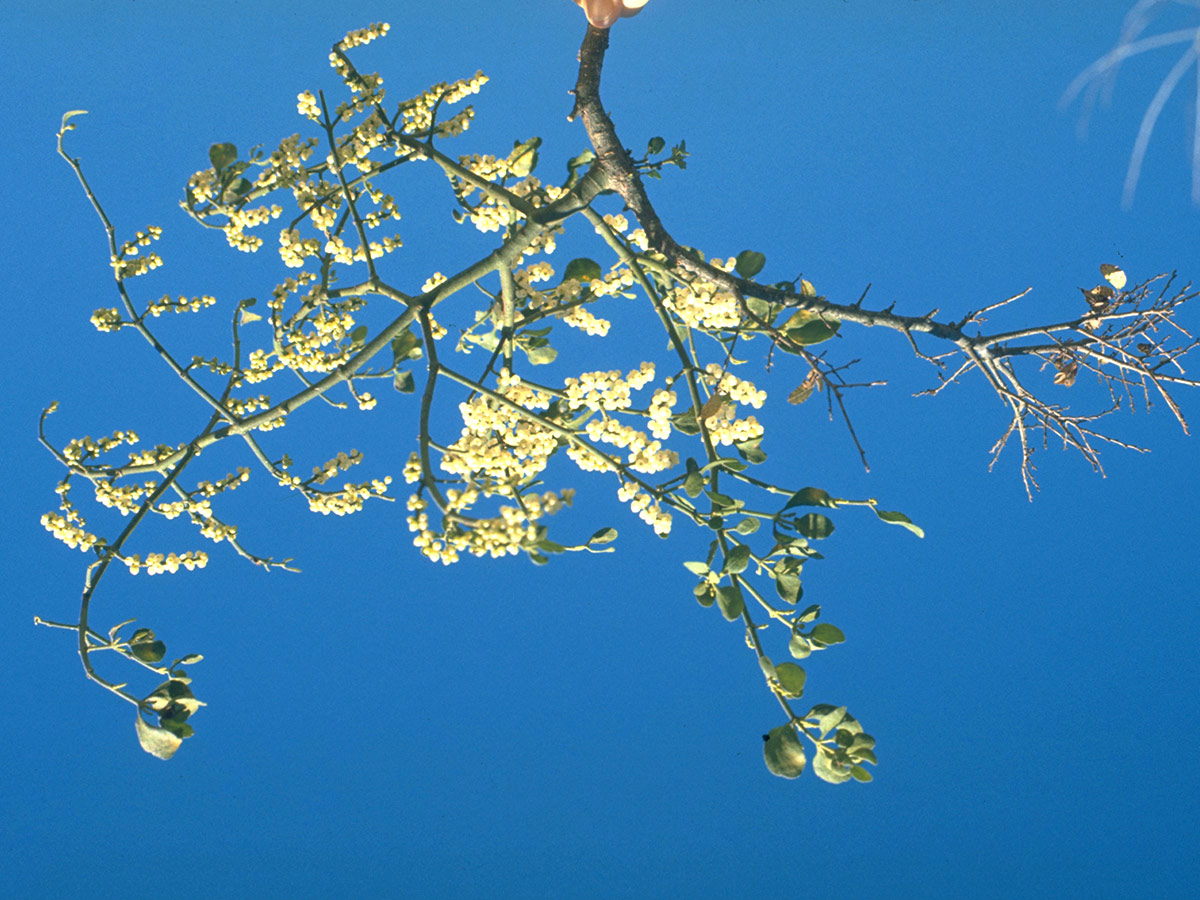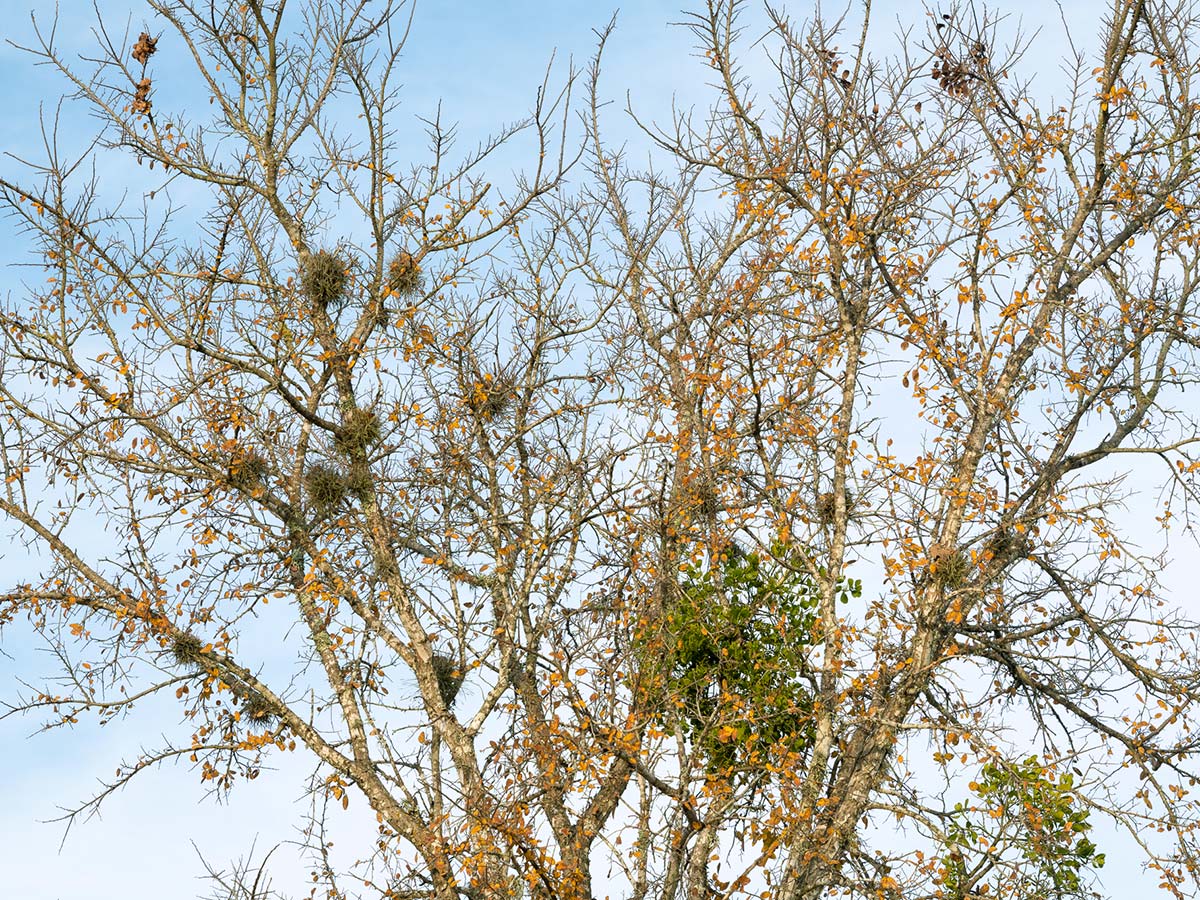Plant a Kiss

Looking up at Phoradendron leucarpum, also known as oak mistletoe. PHOTO Robert L. Stone
People have strong feelings about things in their trees. A possumhaw full of bright red berries, for example, may fill us with unbridled joy. Pine cones have their share of lovers, and wisps of Spanish moss evoke a coastal romance for many. Ball moss is admired by some for its pompom cheer and maligned (incorrectly) by others as a plague.
Then there’s mistletoe. Some of us love the sight of it among a tree’s branches, but many consider it a pest to be removed at the first opportunity. It is, after all, semiparasitic.
Phoradendron species — which are native to North America — are known best for hanging at the holidays and kissing under. But there’s a lot more to them. Here’s a collection of botanic facts and mistletoe lore to keep your mind on native plants this season:
- The genus name Phoradendron comes from the Greek words “phor” for thief and “dendron” for tree — a not-so-thinly veiled accusation since plants of this genus get at least some of their nourishment from the trees on which they grow.
- The white fruit of many mistletoe species ripens in winter and is poisonous to humans but loved by birds, especially waxwings and bluebirds.
- Speaking of birds, mistletoe is fairly easily spread via bird droppings and beaks wiped on branches (nature’s napkins!).
- Native to much of the United States, Phoradendron leucarpum can be found on trees and shrubs from Pennsylvania and New Jersey south to Florida and all the way west to Kansas and New Mexico.
- Mistletoe tends to grow in big bunches; these are called “witches’ brooms” colloquially, and many avian species — including owls — nest in them.
- In more winged-beauty news: The flashy great purple hairstreak butterfly (Atlides halesus) relies on various Phoradendron species as a larval host.
- Though P. leucarpum is more wide-ranging in the United States, P. tomentosum, depicted below, is most common to Central Texas. Wildflower Center Arborist Andrew McNeil-Marshall says it’s “usually confined to hackberries and cedar elms around here.”

A green witches’ broom of Phoradendron tomentosum (and some ball moss) in a cedar elm (Ulmus crassifolia) at the Center. PHOTO Wildflower Center
- The native species more common to western North America is a dwarf mistletoe: Arceuthobium douglasii, or Douglas fir dwarf mistletoe; it grows on pine and cypress trees and provides nesting sites for northern spotted owls.
- According to the National Wildlife Federation, a mistletoe-infested forest with lots of dead trees “may produce three times more cavity-nesting birds,” such as woodpeckers and chickadees, “than a forest lacking mistletoe.”
- Mistletoe has a North Pole connection you might not know: It’s in the taxonomic order Santalales — or shall we say “Santa-lales”?
- The common European species of mistletoe is Viscum album.
- In addition to inspiring spontaneous smooches, mistletoe has been believed capable of the following:
- Banishing evil
- Promoting fertility
- Acting as an aphrodisiac (after all, kissing leads to …)
- Inspiring peace among waring enemies
- Foretelling marriage proposals
Yes, mistletoe can and does kill trees. It is especially harmful during periods of drought, when it takes much-needed water from its host. But it is an undeniably interesting part of our culture and heritage, and it does support wildlife, including squirrels, elk, porcupines, and birds and butterflies we haven’t even mentioned. If you have mistletoe in trees on your property, to cut or keep is obviously up to you. Either way, it’s worth considering mistletoe as more than a kissing catalyst.

